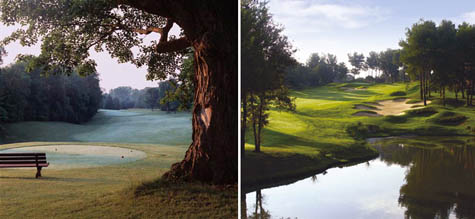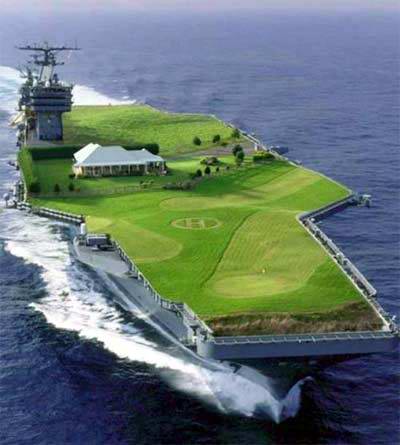Golf amongst the glaciers
In an old book by John McPhee, called In Suspect Terrain, we meet a geologist named Anita Harris who takes McPhee on a tour of post-glacial North American landscapes.
The two of them drive through and discuss "a confused and thus beautiful topography of forested ridges and natural lakes, stone fences, bunkers and bogs, cobbles and boulders under maples and oaks," and they follow the moraines, that line of retreat at which the glaciers stopped, hiking over "hills of rock debris" that were dragged into place – by ice – ten thousand years ago.
 At one point Harris comments that glaciers and golf go together like wind and surfing:
At one point Harris comments that glaciers and golf go together like wind and surfing: And, sure enough, as only one example, if you read about the golf course in Kohler, Wisconsin, you learn the following:
And, sure enough, as only one example, if you read about the golf course in Kohler, Wisconsin, you learn the following:
That landscape itself, in other words, is not only artificial – it is, in fact, a 2000-year old earthwork temporarily lost to view under thickets and autumn leaves (until the golf course came through, clearing the scene) – but the whole thing is also astronomically aligned with the cycles of the moon.
Now that this strange overlay has been discovered, we read, "there is an eagerness among many people to see moonrises from the mounds the way the Indians did, a desire that has caused a conflict with the golf club."
Imagine a golf course deliberately aligned with the universe! You study astronomy with a putter in your hand, hiking amidst coincidence like some strange god on a midwestern hillside.
But the fact that a climatic occurrence ten thousand years ago – the most recent Ice Age – actually formatted the landscape in such a way as to help make golf possible just floors me. That the design of golf courses is thus a continuation of the Ice Age – by means other than geology – is just icing on the cake.
And that this specific type of landscape – the golf course – is then exported, repeated, and cloned, via bulldozer, in decidedly non-glacial landscapes all over the world, from the urban cores of Chinese cities to American military bases in Afghanistan, only adds to the fascination.
 [Image: Found, via a Google Images search, here; some of the comments there beggar belief].
[Image: Found, via a Google Images search, here; some of the comments there beggar belief].
We are the glaciers now™.
(More: Pruned's Of tumuli, moonrises, and a nice Par 3 and John McPhee's In Suspect Terrain).
The two of them drive through and discuss "a confused and thus beautiful topography of forested ridges and natural lakes, stone fences, bunkers and bogs, cobbles and boulders under maples and oaks," and they follow the moraines, that line of retreat at which the glaciers stopped, hiking over "hills of rock debris" that were dragged into place – by ice – ten thousand years ago.
 At one point Harris comments that glaciers and golf go together like wind and surfing:
At one point Harris comments that glaciers and golf go together like wind and surfing:- "This would be a good place for a golf course," Anita remarked, and scarcely had she uttered the words than – after driving two thousand yards on down the road with a dogleg to the left – we were running parallel to the fairways of a clonic Gleneagles, a duplicated Dumfries, a faxed Blairgowrie, four thousand miles from Dumfriesshire and Perthshire, but with natural bunkers and traps of glacial sand, with hummocky roughs and undulating fairways, with kettle depressions, kettle lakes, and other chaotic hazards. "If you want a golf course, go to a glacier" is the message according to Anita Harris. "Golf was invented on the moraines, the eskers, the pitted outwash plains – the glacial topography – of Scotland," she explained. "All over the world, when people make golf courses they are copying glacial landscapes. They are trying to make countryside that looks like this. I've seen bulldozers copying Scottish moraines in places like Louisiana."
 And, sure enough, as only one example, if you read about the golf course in Kohler, Wisconsin, you learn the following:
And, sure enough, as only one example, if you read about the golf course in Kohler, Wisconsin, you learn the following:- The River Course at Blackwolf Run is a commanding layout that offers a dynamic golf challenge with sweeping panoramic views of the Sheboygan River valley. A glacier served as early landscape architect for this site, sculpting river valleys with deep ravines, meadow plains, gentle rolling hills and abundant lakes. Ten thousand years later, Pete Dye took this same piece of land, added his signature style and designed one of the best golf courses in America.
That landscape itself, in other words, is not only artificial – it is, in fact, a 2000-year old earthwork temporarily lost to view under thickets and autumn leaves (until the golf course came through, clearing the scene) – but the whole thing is also astronomically aligned with the cycles of the moon.
Now that this strange overlay has been discovered, we read, "there is an eagerness among many people to see moonrises from the mounds the way the Indians did, a desire that has caused a conflict with the golf club."
Imagine a golf course deliberately aligned with the universe! You study astronomy with a putter in your hand, hiking amidst coincidence like some strange god on a midwestern hillside.
But the fact that a climatic occurrence ten thousand years ago – the most recent Ice Age – actually formatted the landscape in such a way as to help make golf possible just floors me. That the design of golf courses is thus a continuation of the Ice Age – by means other than geology – is just icing on the cake.
And that this specific type of landscape – the golf course – is then exported, repeated, and cloned, via bulldozer, in decidedly non-glacial landscapes all over the world, from the urban cores of Chinese cities to American military bases in Afghanistan, only adds to the fascination.
 [Image: Found, via a Google Images search, here; some of the comments there beggar belief].
[Image: Found, via a Google Images search, here; some of the comments there beggar belief].We are the glaciers now™.
(More: Pruned's Of tumuli, moonrises, and a nice Par 3 and John McPhee's In Suspect Terrain).





Comments are moderated.
If it's not spam, it will appear here shortly!
true about the comments - especially the ones wanting to contact the graphic artist. I'd be happy to photoshop one for them, provided they took on any legal fallout deriving from nutjobs incensed about irreverent use of military imagery.
Hey e-tat - long time no hear. Glad to see you round these parts again!
holy baader-meinhof, i was just explaining the geological impact of glaciers to my girlfriend yesterday.
and that may have been the strangest string of comments i've ever seen on one image.
Geoff,
Just been listening to Camille Paglia... you should listen to her take on a religion of nature:
http://www.radioopensource.org/back-to-god-with-camille-paglia/
Some overlaps with golf, Indians and glaciers. It's all about a sense of perspective, as Douglas Adams would say.
Glacier & Glacier & Assoc.
Landscape Architecture + Golf Ball Concepts LLC
Our Mod-op;
"You Got It!"
Wow, those were amazing comments.
I've always liked glacial landscapes. I've also always liked the idea of golfcourses, with their intricate landscaping, even though I have no interest in the game of golf. Maybe all this time I've been getting some sort of subconscious reminders of the drama of glacial landscapes.
Noel Tatt does actually exist and is a Christmas Card manufacturer, amusingly enough.
The comments on that image are getting increasingly strange - so I think they're made up now. Alas...
But imagine invading the Red Sea – with golf courses.
I don't know if McPhee mentions this in his book, but the word "links" is a Scottish term for a rough, grassy area between the sea and the land. It has well-drained sandy soil that provides a firm golfing surface all year. Only 17% of the colf courses in Scotland are true links, but the older ones are. Most links land is found on the east coast of Scotland. Golf started on links land not only because the land was undulating and extensive, but because it was of little agricultural use:
http://www.scottishgolfhistory.net/links_golf.htm
I've always wondered what the top of Hans Hollein's Aircraft Carrier city looked like. Now I know. Its a golf course.
http://www.moma.org/collection/browse_results.php?criteria=O%3AAD%3AE%3A2705&page_number=1&template_id=1&sort_order=1
Post a Comment